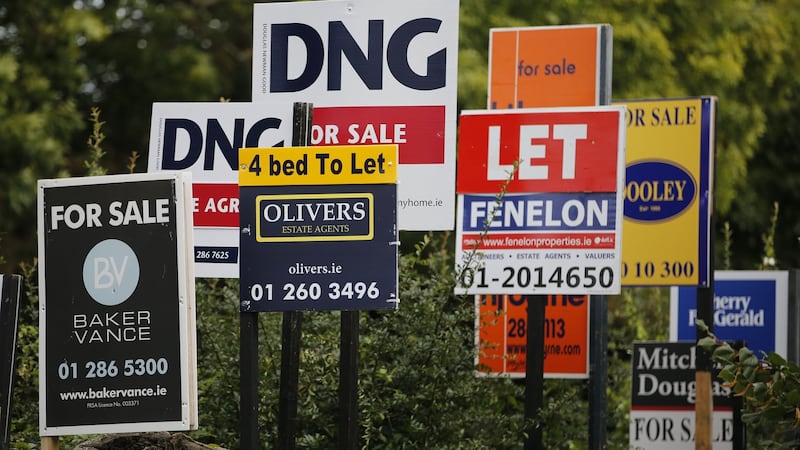Pat (66) has been a residential landlord all his life, but he'd prefer if his full name wasn't published by The Irish Times. "Do you know the opprobrium I would get if I was identified?" he asks. "The hate mail I would get?"
After falling into the sector “by accident”, Pat at one stage had about 80 tenants on his books in 20 properties around Dublin 6 and Dublin 1. “I wouldn’t house one now,” he says. “Not one.”
This, he argues, is due to “appalling treatment” by the Government, and what he calls the “Tesco-isation” of the sector. “What I mean by that is, the small guy who was providing accommodation was put out of business while the bigger players came in.


“These big American companies are coming in and they have no problem with compliance and all the registration and so forth. It’s easy for them because they have the scale, but, for the small guy, it’s murderous.
“Pretty soon, the only people letting properties will be the big huge companies. When tenants have a problem, they’ll ring up a number to say the toilet’s blocked, and they’ll get an answering machine somewhere in the United States.
“There’s never been a bigger demand in history, and yet everyone is running for the exit doors. The Government was telling us what we were allowed to earn. That was the writing on the wall. It’s time to go when that starts happening.”
When Minister for Housing Simon Coveney introduced caps of 4 per cent per annum on rents in pressure zones in the last budget, Pat decided to let his current leases run down before selling off his properties.
He held on to just one or two that he now uses for short-term lets, much the same as the Airbnb model. "I get a lot of students; people on contract work; people who are coming in for maybe a month or six months or something like that.
Stacked deck
“Fair enough, you only get a month here and a month there, but at least you get your property back. You can sell it if you want. You have the comfort of knowing nobody is in it rent free and nobody is wrecking the place.”
The story of the housing and rental crisis has largely been told through the prism of the house buyer and the tenant, but Pat can barely contain his anger at what he perceives to be a stacked deck, and vitriol towards landlords among the public.
“I heard on the radio that people letting on Airbnb don’t pay any taxes,” he says. “I pay all my taxes in full. How can people say these things when they aren’t true? You’re a greedy landlord. It’s like something from the time of the famine that I’m a guy who sits on a horse and kicks peasants around the place.”
Indeed, Pat is not alone. Irish Property Owners’ Association spokeswoman Margaret McCormack says one of the biggest problems in the sector is the “constant Government interference”.
One of the key issues she highlights is how mortgage interest relief, which was once deductible at 100 per cent, was cut to 75 per cent in 2009. “This was around the same time rents were decreasing, in some cases as much as 50 per cent,” she says.
“They only treated the residential sector like this. They didn’t do it to the commercial sector. It just shows you what they consider more important.
“Over the period of time, we had a surplus of accommodation. Rents were going down because of supply and demand, so we had a situation where we were well supplied but because of the tax treatment, between 12,000 and 14,000 landlords left the sector.”
McCormack says the treatment of landlords has not gotten much better, and that there is virtually no sympathy from the public or Government.
“If you buy a washing machine, you can only offset the item over eight years at 12.5 per cent a year. But normally you are buying the item up front, so by the time you’re actually offsetting it, you’re buying a new one again. There’s a cash flow problem all the time.”
Complex and difficult
She says the Residential Tenancies Acts, which govern the sector, are “complex and difficult”, as well as being “really, really hard” to comply with. “That’s coming from somebody who is very familiar with the legislation,” she says.
“Even to do simple things like serve a notice of termination, it’s really difficult to get it right. There are so many items that have to be in place, and if there’s something wrong the notice isn’t valid.
“With all the increased legislation, people have increased rights. In a situation where you have a couple of people sharing, one person can disrupt the house. The landlord may not be told about them.
“To get someone like that out, the landlord has to write to the tenant and outline the misbehaviour. Then, the other people have to stand up and be counted while they continue to live with this person.
“Inevitably, rather than go through the Residential Tenancies Board with all the conflict, the other tenants just move on and you’re left with the tenant who causes difficulty for everyone. Others who move in won’t stay long.”
Recent changes to the law by successive ministers for the environment have ensnared some landlords who were letting properties below market rate. First, there was Alan Kelly’s two-year rent freeze. That was shortly followed by Coveney’s 4 per cent caps.
“You have an awful lot of landlords who kept rent much lower than the market rate,” says McCormack. “They are now restricted again. But there’s nothing there that indicates their means to pay back their loans.”
What all of that means is that thousands of landlords are fleeing the private rental sector and going down the Airbnb route.
“There is more work involved but they get a higher income from it,” says McCormack. “The wear and tear can be less because people coming in on holidays don’t tend to use the cooker. On that side, there is less cost on repair and replacement.”
Earlier this year, Keith Lowe, chief executive of estate agent Douglas Newman Good, noticed a lot of landlords in branches around the country looking to sell. Curious about what was happening, he took a count of just how many there were.
Buy-to-let properties
“We got to 50 per cent of our branches, and everyone was giving us nearly the same answer, which was that about 20 per cent of the stock they were selling was buy-to-let properties,” he says.
“In Dublin, it was as high as 27 per cent. In our Phibsborough office, on that particular date in March, 45 per cent of all the houses we were selling were buy-to-lets. We thought that was very significant.
“Airbnb has a huge influence on the sector. There’s a particular development in the docklands where there are more than 40 Airbnb units. Those units would initially have been standard lettings. That is again reducing the supply into the sector.”
Lowe says the majority of these properties are being bought by owner occupiers. “That’s good news for people looking to buy a house, and it’s good news in terms of the pressure on new home construction, but it’s very bad news for tenants,” he says.
Another issue is that the rules don’t apply to new lets. The State’s largest landlord, Ires Reit, has set rents at its new Sandyford development at an eye-watering €2,570 for a two-bed apartment.
A spokesman for the company insists the rates were not set to circumvent Coveney’s rules. “No,” he says. “The apartments are premium quality. They’re new, very high-end, and the rent is reflective of that.”
Like many others, Ires Reit says supply is the key issue in the crisis. “What we should be doing is encouraging supply through initiatives in planning, regulation and allowing for higher density. From our point of view, we’re referring to the recent planning application that was turned down in Sandyford.”
The company recently expressed “serious disappointment” after Dún Laoghaire-Rathdown County Council refused permission for its planned development of 465 apartments at the Rockbrook scheme in the south Dublin suburb.
Growing student population
One chink of light on the horizon is the very high volume of student rental accommodation being constructed. In December, estate agent Hines entered the market with the acquisition of four major sites that will deliver about 1,500 new beds for Dublin’s growing student population.
“Demand for high-quality, safe, well-located accommodation is increasing,” it says. “We are very happy to be a part of solving Dublin’s housing supply issues by investing in the sector and expect it to tie in well with our residential development plans.”
The Binary Hub, located in the heart of the city, was completed in July and provides 470 beds. Developments on Dorset Street and Summerhill are due to be completed this year and next, providing 450 and 400 beds respectively.
The fourth scheme in the portfolio, a development site on Cork Street, is subject to planning approval and could be delivered by 2019.
However, with 81,000 new homes needed to meet demand by 2020, the State is going to have to do more to keep the Pats of this world in the market.











